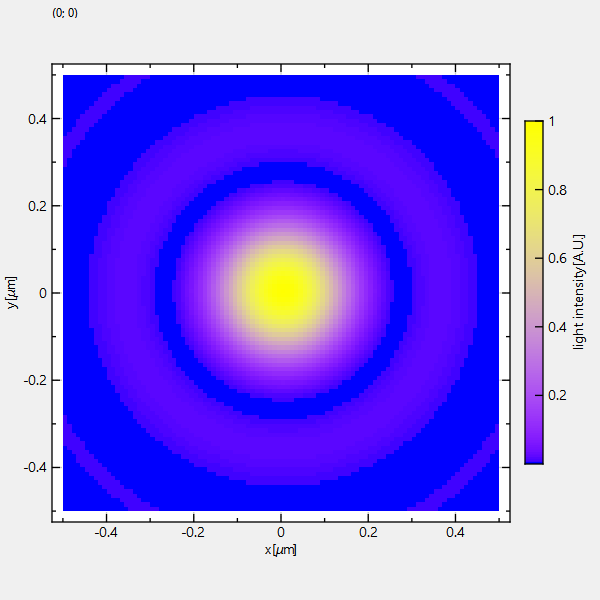mirror of
https://github.com/jkriege2/JKQtPlotter.git
synced 2024-11-16 02:25:50 +08:00
111 lines
5.1 KiB
Markdown
111 lines
5.1 KiB
Markdown
# Example (JKQTPlotter): Simple math image plot without use of central JKQTdatastore {#JKQTPlotterImagePlotNoDatastore}
|
|
This project (see `./examples/imageplot_nodatastore/`) simply creates a JKQTPlotter widget (as a new window) and adds a color-coded image plot of a mathematical function (here the Airy disk). The image is stored as a simple C-array in row-major ordering and then given to a JKQTPMathImage to visualize it. The data is stored as a pointer directly in the JKQTPMathImage object. There is also a variant JKQTPColumnMathImage of JKQTPMathImage, which references a column in the internal JKQTdatastore and uses the data there for plotting. In both cases data has to be organized as a row-major matrix of values. JKQTPMathImage supports different dataytpes ([u]nit8/16/32/64,float,double see `JKQTPMathImageBase::DataType`) that can be configured e.g. by `setData()`.
|
|
|
|
The source code of the main application is (see [`imageplot_nodatastore.cpp`](https://github.com/jkriege2/JKQtPlotter/tree/master/examples/imageplot_nodatastore/imageplot_nodatastore.cpp):
|
|
```.cpp
|
|
#include <QApplication>
|
|
#include <cmath>
|
|
#include "jkqtplotter/jkqtplotter.h"
|
|
#include "jkqtplotter/graphs/jkqtpimage.h"
|
|
|
|
#ifndef M_PI
|
|
#define M_PI 3.14159265358979323846
|
|
#endif
|
|
|
|
|
|
int main(int argc, char* argv[])
|
|
{
|
|
QApplication app(argc, argv);
|
|
|
|
JKQTPlotter plot;
|
|
// 1. create a plotter window and get a pointer to the internal datastore (for convenience)
|
|
plot.getPlotter()->setUseAntiAliasingForGraphs(true); // nicer (but slower) plotting
|
|
plot.getPlotter()->setUseAntiAliasingForSystem(true); // nicer (but slower) plotting
|
|
plot.getPlotter()->setUseAntiAliasingForText(true); // nicer (but slower) text rendering
|
|
|
|
// 2. now we create data for the charts (taken from https://commons.wikimedia.org/wiki/File:Energiemix_Deutschland.svg)
|
|
const int NX=100; // image dimension in x-direction [pixels]
|
|
const int NY=100; // image dimension in x-direction [pixels]
|
|
const double dx=1e-2; // size of a pixel in x-direction [micrometers]
|
|
const double dy=1e-2; // size of a pixel in x-direction [micrometers]
|
|
const double w=static_cast<double>(NX)*dx;
|
|
const double h=static_cast<double>(NY)*dy;
|
|
double airydisk[NX*NY]; // row-major image
|
|
|
|
// 2.1 Parameters for airy disk plot (see https://en.wikipedia.org/wiki/Airy_disk)
|
|
double NA=1.1; // numerical aperture of lens
|
|
double wavelength=488e-3; // wavelength of the light [micrometers]
|
|
|
|
// 2.2 calculate image of airy disk in a row-major array
|
|
double x, y=-h/2.0;
|
|
for (int iy=0; iy<NY; iy++ ) {
|
|
x=-w/2.0;
|
|
for (int ix=0; ix<NX; ix++ ) {
|
|
const double r=sqrt(x*x+y*y);
|
|
const double v=2.0*M_PI*NA*r/wavelength;
|
|
airydisk[iy*NX+ix] = pow(2.0*j1(v)/v, 2);
|
|
x+=dx;
|
|
}
|
|
y+=dy;
|
|
}
|
|
|
|
|
|
// 3. create a graph (JKQTPMathImage) with referencing the data created above as data
|
|
// The data is color-coded with the color-palette JKQTPMathImageBLUEYELLOW
|
|
// the converted range of data is determined automatically because setAutoImageRange(true)
|
|
JKQTPMathImage* graph=new JKQTPMathImage(&plot);
|
|
graph->setTitle("");
|
|
// set array as datasource, with correct size NX*NY and datatype JKQTPMathImageBase::DataType::DoubleArray
|
|
graph->setData(airydisk, NX, NY, JKQTPMathImageBase::DataType::DoubleArray);
|
|
// where does the image start in the plot, given in plot-axis-coordinates (bottom-left corner)
|
|
graph->setX(-w/2.0);
|
|
graph->setY(-h/2.0);
|
|
// width and height of the image in plot-axis-coordinates
|
|
graph->setWidth(w);
|
|
graph->setHeight(h);
|
|
// color-map is "BLUEYELLOW"
|
|
graph->setPalette(JKQTPMathImageBLUEYELLOW);
|
|
// get coordinate axis of color-bar and set its label
|
|
graph->getColorBarRightAxis()->setAxisLabel("light intensity [A.U.]");
|
|
// determine min/max of data automatically and use it to set the range of the color-scale
|
|
graph->setAutoImageRange(true);
|
|
// you can set the color-scale range manually by using:
|
|
// graph->setAutoImageRange(false);
|
|
// graph->setImageMin(0);
|
|
// graph->setImageMax(10);
|
|
|
|
|
|
// 4. add the graphs to the plot, so it is actually displayed
|
|
plot.addGraph(graph);
|
|
|
|
|
|
// 5. set axis labels
|
|
plot.getXAxis()->setAxisLabel("x [{\\mu}m]");
|
|
plot.getYAxis()->setAxisLabel("y [{\\mu}m]");
|
|
|
|
|
|
// 6. fix axis and plot aspect ratio to 1
|
|
plot.getPlotter()->setMaintainAspectRatio(true);
|
|
plot.getPlotter()->setMaintainAxisAspectRatio(true);
|
|
|
|
// 7. autoscale the plot so the graph is contained
|
|
plot.zoomToFit();
|
|
|
|
// show plotter and make it a decent size
|
|
plot.show();
|
|
plot.resize(600,600);
|
|
plot.setWindowTitle("JKQTPMathImage");
|
|
|
|
|
|
return app.exec();
|
|
}
|
|
```
|
|
|
|
The result looks like this:
|
|
|
|

|
|
|
|
See [`examples/imageplot`](https://github.com/jkriege2/JKQtPlotter/tree/master/examples/imageplot) for a detailed description of the other possibilities that the class JKQTPColumnMathImage (and also JKQTPMathImage) offer with respect to determining how an image is plottet.
|
|
|
|
|